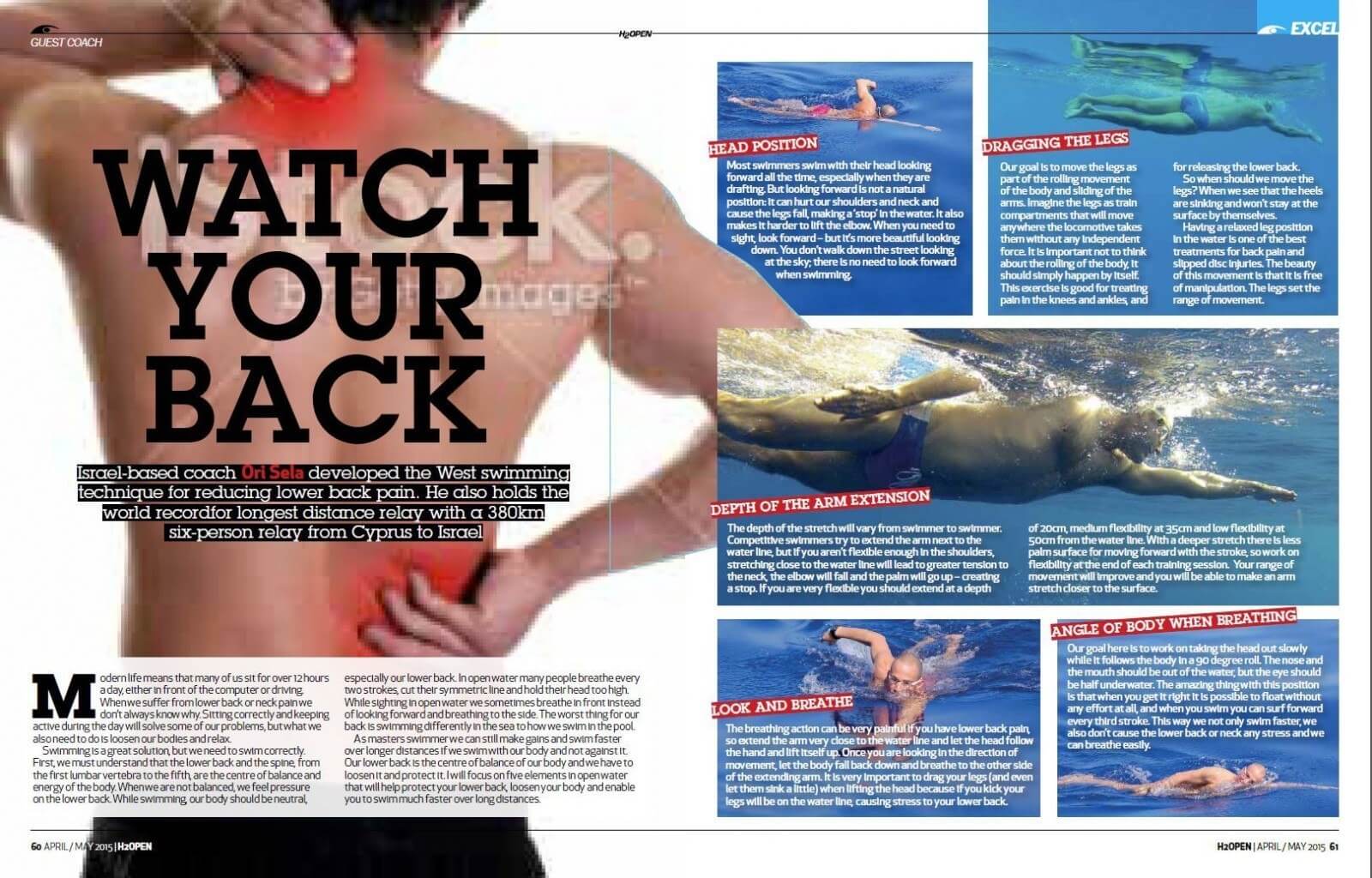Learn more:
How to swim faster, looser and protect your lower back with the swim WEST technique, the healthiest swimming technique in the world and get a 50% off on your first online swimming course>>>
Watch your back
Israel-based coach Ori Sela developed the WEST swimming technique for reducing lower back pain. In 2014 he was part of a six-person relay team that swam 377km from Cyprus to Israel
Modern life means that many of us sit for more than 12 hours a day, either in front of the computer or driving. When we suffer from lower back or neck pain we don’t always know why. Sitting correctly and keeping active during the day will solve some of our problems, but what we also need to do is loosen our bodies and relax.
Swimming is a great solution, but we need to swim correctly. First, we must understand that the lower back and the spine, from the first lumbar vertebra to the fifth, are the centre of balance and energy of the body. When we are not balanced, we feel pressure on the lower back. While swimming, our body should be neutral, especially our lower back. In open water many people breathe every two strokes, cut their symmetric line and hold their head too high. While sighting in open water we sometimes breathe in front instead of looking forward and breathing to the side. The worst thing for our back is swimming differently in the sea to how we swim in the pool.
As masters swimmers we can still make gains and swim faster over longer distances if we swim with our body and not against it. Our lower back is the centre of balance of our body and we have to loosen it and protect it. I will focus on five elements in open water that will help protect your lower back, loosen your body and enable you to swim much faster over long distances.
Why swim WEST in open water?
1. Head position
Most swimmers swim with their head looking forward all the time, especially when they are drafting. But looking forward is not a natural position: it can hurt our shoulders and neck and cause the legs fall, making a ‘stop’ in the water. It also makes it harder to lift the elbow. When you need to sight, look forward – but it’s more beautiful looking down. You don’t walk down the street looking at the sky; there is no need to look forward when swimming.
2. Dragging the legs
Our goal is to move the legs as part of the rolling movement of the body and sliding of the arms. Imagine the legs as train compartments that will move anywhere the locomotive takes them without any independent force. It is important not to think about the rolling of the body, it should simply happen by itself. This exercise is good for treating pain in the knees and ankles, and for releasing the lower back.
So when should we move the legs? When we see that the heels are sinking and won’t stay at the surface by themselves.
Having a relaxed leg position in the water is one of the best treatments for back pain and slipped disc injuries. The beauty of this movement is that it is free of manipulation. The legs set the range of movement.
3. Depth of the arm extension
The depth of the stretch will vary from swimmer to swimmer. Competitive swimmers try to extend the arm next to the water line, but if you aren’t flexible enough in the shoulders, stretching close to the water line will lead to greater tension to the neck, the elbow will fall and the palm will go up – creating a stop. If you are very flexible you should extend at a depth of 20cm, medium flexibility at 35cm and low flexibility at 50cm from the water line. With a deeper stretch there is less palm surface for moving forward with the stroke, so work on flexibility at the end of each training session. Your range of movement will improve and you will be able to make an arm stretch closer to the surface.
4. Look and breathe
The breathing action when swimming freestyle can be very painful if you have lower back pain, so extend the arm very close to the water line and let the head follow the hand and lift itself up. Once you are looking in the direction of movement, let the body fall back down and breathe to the other side of the extending arm. It is very important to drag your legs (and even let them sink a little) when lifting the head because if you kick your legs will be on the water line, causing stress to your lower back.
5. Angle of body when breathing
Our goal here is to work on taking the head out slowly while it follows the body in a 90 degree roll. The nose and the mouth should be out of the water, but the eye should be half underwater.
The amazing thing with this position is that when you get it right it is possible to float without any effort at all, and when you swim you can surf forward every third stroke. This way we not only swim faster, we also don’t cause the lower back or neck any stress and we can breathe easily.
Many people change their swimming technique when swimming in open water and that’s wrong, try to swim WEST and you will fell the change in your body and in your speed
Articles related:
How to breathe in freestyle and protect your lower back>>
How to make your food for long distance open water swims>>
How to work with the write pulse when swimming>>
How to build a good training program for open water swims>>
Get 50% off on your first learn to swim freestyle online course>>




